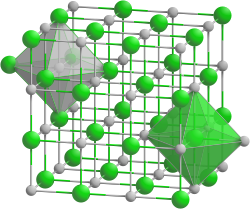Uranium (IV) carbide
| Crystal structure | ||||||||||
|---|---|---|---|---|---|---|---|---|---|---|

|
||||||||||
| __ U 4+ __ C 4− | ||||||||||
| Crystal system | ||||||||||
| Space group |
Fm 3 m (No. 225) |
|||||||||
| General | ||||||||||
| Surname | Uranium (IV) carbide | |||||||||
| other names |
Uranium monocarbide |
|||||||||
| Ratio formula | UC | |||||||||
| Brief description |
gray-black solid |
|||||||||
| External identifiers / databases | ||||||||||
|
||||||||||
| properties | ||||||||||
| Molar mass | 250.04 g mol −1 | |||||||||
| Physical state |
firmly |
|||||||||
| density |
13.63 g cm −3 |
|||||||||
| Melting point |
2370-2790 ° C |
|||||||||
| Hazard and safety information | ||||||||||
 Radioactive |
||||||||||
|
||||||||||
| As far as possible and customary, SI units are used. Unless otherwise noted, the data given apply to standard conditions . | ||||||||||
Uranium (IV) carbide is an inorganic chemical compound from the group of carbides and one of several known uranium carbides .
presentation
Uranium (IV) carbide can be obtained by reacting uranium and graphite in a vacuum arc furnace.
To produce ceramic moldings (e.g. reactor pellets), a mixture of uranium dioxide or uranium (V, VI) oxide is pressed with graphite and sintered at 2250 ° C.
It is also possible to produce it by reacting uranium with methane at 600 ° C.
Uranium (IV) carbide is a gray-black, crystalline mass with a shiny metallic surface. It has a crystal structure of the sodium chloride type with a homogeneity area ( a = 496.1–495.9 pm ). It reacts with oxygen and molten beryllium , nickel , zirconium and silicon as well as with water.
use
Uranium (IV) carbide is used as a reactor fuel.
Individual evidence
- ↑ a b c d e Georg Brauer (Hrsg.): Handbook of Preparative Inorganic Chemistry . 3., reworked. Edition. tape II . Enke, Stuttgart 1978, ISBN 3-432-87813-3 , p. 1241 .
- ↑ a b Werner Martienssen, Hans Warlimont: Springer Handbook of Condensed Matter and Materials Data . Springer, 2006, ISBN 3-540-30437-1 , pp. 464 ( limited preview in Google Book search).
- ↑ Entry on uranium compounds in the GESTIS substance database of the IFA , accessed on February 1, 2016 (JavaScript required)
- ↑ Not explicitly listed in Regulation (EC) No. 1272/2008 (CLP) , but with the specified labeling it falls under the group entry uranium compounds with the exception of those specified elsewhere in this Annex in the Classification and Labeling Inventory of the European Chemicals Agency (ECHA) , accessed on February 1, 2016. Manufacturers or distributors can expand the harmonized classification and labeling .
- ↑ The hazards emanating from radioactivity do not belong to the properties to be classified according to the GHS labeling.
- ↑ IN Tumanov: Plasma and High Frequency Processes for Obtaining and Processing Materials ... Nova Publishers, 2003, ISBN 1-59033-009-9 , S. 218 ( limited preview in Google Book search).
- ^ JJ Zuckerman: Inorganic Reactions and Methods, Formation of Ceramics . John Wiley & Sons, 2009, ISBN 0-470-14554-4 , pp. 349 ( limited preview in Google Book search).
- ^ Dale L. Perry: Handbook of Inorganic Compounds, Second Edition . Taylor & Francis US, 2011, ISBN 1-4398-1462-7 , pp. 488 ( limited preview in Google Book search).
- ↑ Pedro Oliveira: The Elements . S. 1239 ( limited preview in Google Book search).
- ↑ United States. Office of Saline Water: Proceedings . US Dept. of the Interior, Office of Saline Water; [for sale by the Subs. of Docs., US Govt. Print. Off., 1965, p. 91 ( limited preview in Google Book search).





